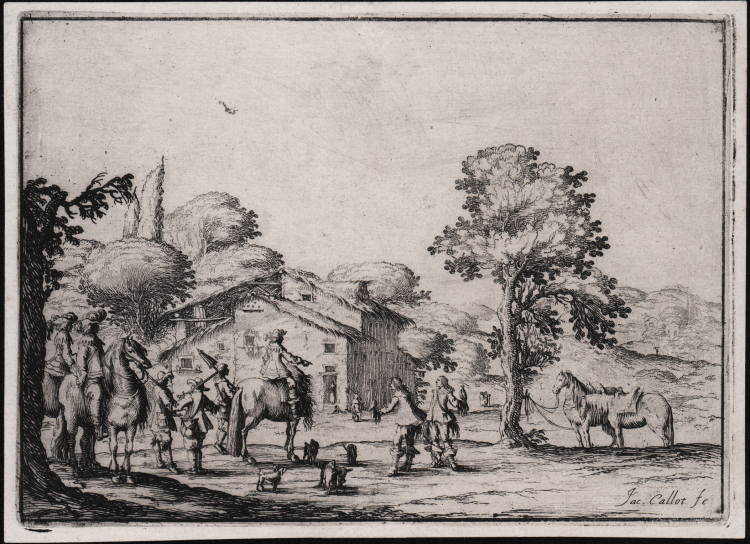




| Reference: | S43004 |
| Author | Ercole BAZZICALUVA |
| Year: | 1638 |
| Measures: | 170 x 120 mm |



| Reference: | S43004 |
| Author | Ercole BAZZICALUVA |
| Year: | 1638 |
| Measures: | 170 x 120 mm |
Etching, 1638 circa, lettered lower right, in the image “Jac. Callot fe.”
Very good example, printed on contemporary paper, with thin margins, in perfect condition.
The etcher Ercole Bazicaluva, also called Fiorentino, was taught by Giulio Parigi in Florence and was a fellow student of Jacques Callot, by whom he was greatly influenced. He produced a small body of etchings, typical of which are an unpolished, down-to-earth technique and a pronounced decorative effect.
The artist from Pisa signed himself Ercole Bazicaluva, Bazzicaluna, Bazzicaluve, and Bazzicalune. His landscape drawings suggest that Tuscan feeling of pleasure for country life. In 1638 he produced etchings with a series of marine subjects and landscapes that he described, in his dedication to Ferdinando II de' Medici, Grand Duke of Tuscany, as 'extraordinary and imaginary lands'.
The frontispiece to a set of twelve plates, that was unknown to Bartsch, who only mentions a reference to them in Heineken's dictionary. The Illustrated Bartsch reproduces a later state of this sheet in Boston, which has the address of Rossi. This enables the set to be identified on p. 87 of the 1735 Rossi catalogue (A. Grelle Iusco p. 314) as 'Paesi con la fama, di Ercole Bazicaluve in 12 mezzi fogli reali: bajocchi 30'.
Although these are early works, they are nevertheless elegantly composed and balanced, and recall the luminous spaces and soft vegetation that we also find in the works of Stefano della Bella and Filippo Napoletano.
Few of the engravings bear the artist's full name and surname; given the limited production, his prints soon became rare.
Ercole BAZZICALUVA (Pisa, 1610 circa; Firenze, dopo 1641).
|
Italian draughtsman and engraver. After studying at Giulio Parigi’s academy, he became first a ‘servant of His Serene Highness the Archduke of Innsbruck, then castellan of the old fortress of Livorno, and finally of the fortress of Pisa’ (Baldinucci). Art was not his main interest, yet Baldinucci described him as ‘a brilliant draughtsman in pen and ink’, and his drawings, which are mainly of subjects inspired by his experience of military occupations, hunts and battles, are highly accomplished. His landscape drawings, which include a View of the Valley of the Arno, with the Villa Ambrogiana (1633; Florence, Bib. Marucelliana), a rare example of a dated drawing, and his Landscape with Rustic Houses and Muleteer (Florence, Uffizi), convey a Tuscan feeling for the pleasures of country life. A group of studies of trees (Florence, Uffizi), reminiscent of similar drawings by Paul Bril, delight in the effects of gnarled roots and tree trunks decoratively patterned against the sky. In 1638 he etched a series of marines and landscapes, which he described, in the dedication to Ferdinand II de’ Medici, Grand Duke of Tuscany, as ‘rare and imaginary lands’. Although these are early works, they are elegantly composed, reminiscent, in their skilled rendering, of the luminous space and soft vegetation of the art of Stefano della Bella and Filippo Napoletano. In four engravings of military episodes (1641) the compositions, with a deeply shadowed foreground set against a deep, broad landscape, are derived from prints by Antonio Tempesta. In the same year Bazzicaluva produced 13 prints for Bartolommeo Bocchini’s mock heroic poem Le pazzie dei Savi, o vero il Lambertaccio (1641). A series of six etchings of hunts, of unknown date, are very close to the style of della Bella
|
Ercole BAZZICALUVA (Pisa, 1610 circa; Firenze, dopo 1641).
|
Italian draughtsman and engraver. After studying at Giulio Parigi’s academy, he became first a ‘servant of His Serene Highness the Archduke of Innsbruck, then castellan of the old fortress of Livorno, and finally of the fortress of Pisa’ (Baldinucci). Art was not his main interest, yet Baldinucci described him as ‘a brilliant draughtsman in pen and ink’, and his drawings, which are mainly of subjects inspired by his experience of military occupations, hunts and battles, are highly accomplished. His landscape drawings, which include a View of the Valley of the Arno, with the Villa Ambrogiana (1633; Florence, Bib. Marucelliana), a rare example of a dated drawing, and his Landscape with Rustic Houses and Muleteer (Florence, Uffizi), convey a Tuscan feeling for the pleasures of country life. A group of studies of trees (Florence, Uffizi), reminiscent of similar drawings by Paul Bril, delight in the effects of gnarled roots and tree trunks decoratively patterned against the sky. In 1638 he etched a series of marines and landscapes, which he described, in the dedication to Ferdinand II de’ Medici, Grand Duke of Tuscany, as ‘rare and imaginary lands’. Although these are early works, they are elegantly composed, reminiscent, in their skilled rendering, of the luminous space and soft vegetation of the art of Stefano della Bella and Filippo Napoletano. In four engravings of military episodes (1641) the compositions, with a deeply shadowed foreground set against a deep, broad landscape, are derived from prints by Antonio Tempesta. In the same year Bazzicaluva produced 13 prints for Bartolommeo Bocchini’s mock heroic poem Le pazzie dei Savi, o vero il Lambertaccio (1641). A series of six etchings of hunts, of unknown date, are very close to the style of della Bella
|